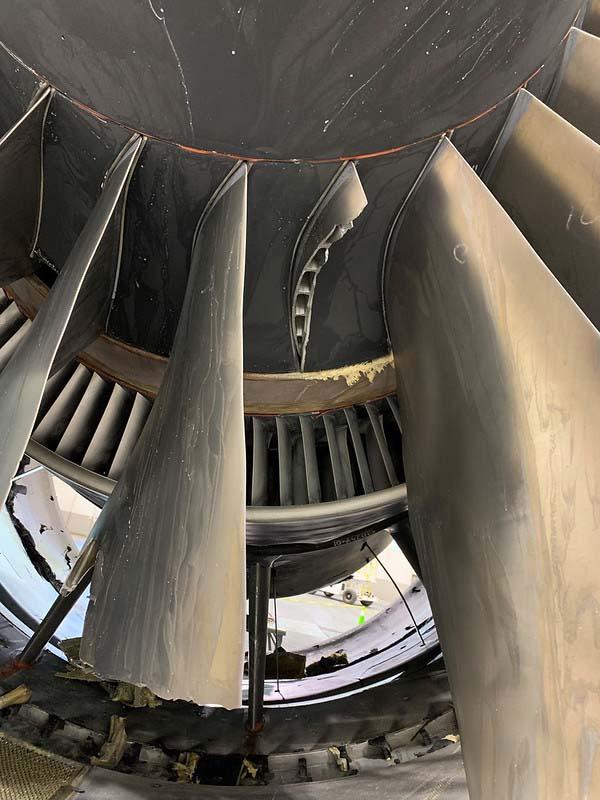
Preliminary data released by the NTSB regarding the agency’s investigation into the Feb 20. in-flight failure of a Pratt & Whitney PW4077 on a United Airlines Boeing 777-200ER over Colorado confirm the fracture surface of the broken blade at the center of the event was consistent with fatigue damage.
The engine failure, which occurred shortly after United Flight 328 took off from Denver International Airport, was the third such event involving a PW4077-powered 777 in three years and has raised questions about current inspection protocols and intervals. Although the failed fan was contained within the engine case, the associated damage to the inlet, cowling and airframe has also prompted concerns over design safety standards for higher bypass engine nacelles.
The two previous failures on a United 777 in February 2018 and a Japan Airlines (JAL) aircraft in December 2020 were both linked to fatigue failures of the PW4077’s 112-in. diameter fan blades. Although the NTSB cautions that initial inspections do not yet confirm fatigue as the specific cause in the United 328 case it adds that preliminary metallurgical findings from a scanning electron microscope examination at Pratt & Whitney “identified multiple fatigue fracture origins on the interior surface of a cavity within the blade.”
The agency adds that “efforts to further characterize the fracture surface, including identifying the primary origin and counting striations, are ongoing.” In a similar pattern to the previous incidents, the blade with the initial failure fractured 7.5 in. above the base at the trailing edge while the second, adjacent, fractured blade “exhibited indications of overload failure, consistent with secondary damage.”

The NTSB also says the review of maintenance and inspection data for the blade revealed it had experienced 2,979 cycles since its last inspection. The blade underwent thermal acoustic image (TAI) inspections in 2014 and 2016. Data collected from the 2016 inspection was examined again in 2018 because of the February 2018 event, the NTSB adds.
The United investigation prompted Pratt to make several changes to its 112-in. blade inspection program and review records for all 9,600 blades that had been overhauled. About 300 blades were removed as a result. Pratt also recommended a new maximum interval of 6,500 cycles between TAI inspections, which the FAA mandated in March 2019. However, following the more recent JAL event Japanese transport officials ordered immediate visual inspections of the PW4000-series blades and, after consulting with Pratt. reduced the maximum TAI inspection interval to 1,500 cycles in late January.
Following the most recent incident, Pratt again revised the recommended interval, this time to 1,000 cycles. The FAA then mandated immediate TAI inspections before further flight and will set a mandatory interval based on findings.
Another key aspect of the United 328 incident was a persistent fire in the heavily damaged engine which was filmed from the cabin by passengers. The NTSB update says “initial examination of the right engine fire damage found it was primarily contained to the engine’s accessory components, thrust reverser skin, and composite honeycomb structure of the inboard and outboard thrust reversers.” The NTSB adds that the spar valve, which stops fuel flow to the engine when the fire switch is pulled in the cockpit, was found closed. “There was no evidence of a fuel-fed fire,” it adds.



